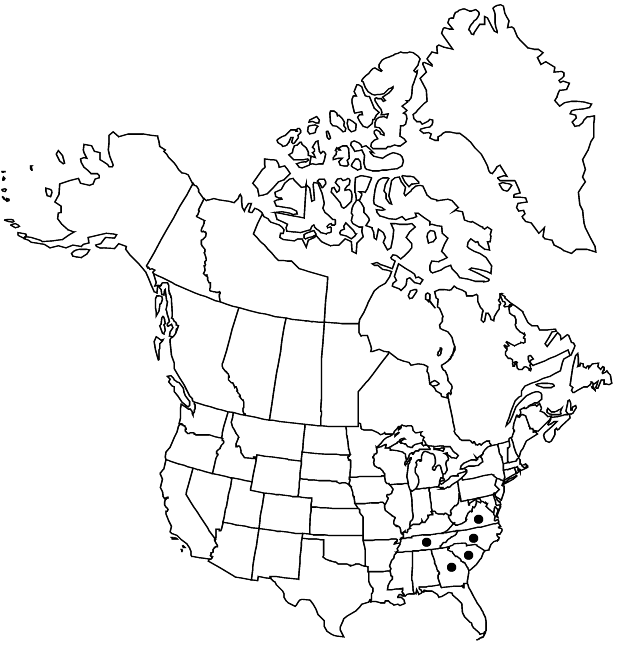Difference between revisions of "Shortia galacifolia var. galacifolia"
Common names: Southern shortia
FNA>Volume Importer |
FNA>Volume Importer |
||
| Line 1: | Line 1: | ||
{{Treatment/ID | {{Treatment/ID | ||
|accepted_name=Shortia galacifolia var. galacifolia | |accepted_name=Shortia galacifolia var. galacifolia | ||
| − | |accepted_authority= | + | |accepted_authority= |
|publications= | |publications= | ||
|common_names=Southern shortia | |common_names=Southern shortia | ||
| Line 20: | Line 20: | ||
|elevation=200-700 m | |elevation=200-700 m | ||
|distribution=Ga.;N.C.;S.C.;Tenn.;Va. | |distribution=Ga.;N.C.;S.C.;Tenn.;Va. | ||
| − | |discussion=<p>Variety galacifolia is native in humid gorges of the Blue Ridge escarpment in Jackson and Transylvania counties, North Carolina; Oconee and Pickens counties, South Carolina; and Rabun County, Georgia. The type locality and nearby populations, probably as much as 60% of the entire species, were destroyed by the construction of Lake Jocassee (South Carolina) in the early 1960s. Adventive populations of < | + | |discussion=<p>Variety galacifolia is native in humid gorges of the Blue Ridge escarpment in Jackson and Transylvania counties, North Carolina; Oconee and Pickens counties, South Carolina; and Rabun County, Georgia. The type locality and nearby populations, probably as much as 60% of the entire species, were destroyed by the construction of Lake Jocassee (South Carolina) in the early 1960s. Adventive populations of <i></i>var.<i> galacifolia</i> apparently have been naturalized or at least persist from cultivation in Tennessee and Virginia and farther north in North Carolina.</p><!-- |
--><p>of conservation concern</p> | --><p>of conservation concern</p> | ||
|tables= | |tables= | ||
| Line 30: | Line 30: | ||
-->{{#Taxon: | -->{{#Taxon: | ||
name=Shortia galacifolia var. galacifolia | name=Shortia galacifolia var. galacifolia | ||
| − | + | |authority= | |
| − | |authority= | ||
|rank=variety | |rank=variety | ||
|parent rank=species | |parent rank=species | ||
| Line 45: | Line 44: | ||
|publication year= | |publication year= | ||
|special status= | |special status= | ||
| − | |source xml=https://jpend@bitbucket.org/aafc-mbb/fna-data-curation.git/src/ | + | |source xml=https://jpend@bitbucket.org/aafc-mbb/fna-data-curation.git/src/f50eec43f223ca0e34566be0b046453a0960e173/coarse_grained_fna_xml/V8/V8_661.xml |
|genus=Shortia | |genus=Shortia | ||
|species=Shortia galacifolia | |species=Shortia galacifolia | ||
Revision as of 22:30, 16 December 2019
Flowers: corolla lobes 16–25 mm; styles (10–)12–18 mm. 2n = 12.
Phenology: Flowering Mar–Apr.
Habitat: Moist slopes and ravines, stream banks, rock outcrops and cliffs, rich hardwoods, commonly under hemlock (Tsuga canadensis), white pine (Pinus strobus), or tulip poplar (Liriodendron tulipifera), Rhododendron maximum, R. minus, and Kalmialatifolia
Elevation: 200-700 m
Distribution

Ga., N.C., S.C., Tenn., Va.
Discussion
Variety galacifolia is native in humid gorges of the Blue Ridge escarpment in Jackson and Transylvania counties, North Carolina; Oconee and Pickens counties, South Carolina; and Rabun County, Georgia. The type locality and nearby populations, probably as much as 60% of the entire species, were destroyed by the construction of Lake Jocassee (South Carolina) in the early 1960s. Adventive populations of var. galacifolia apparently have been naturalized or at least persist from cultivation in Tennessee and Virginia and farther north in North Carolina.
of conservation concern
Selected References
None.
Lower Taxa
None.
... more about "Shortia galacifolia var. galacifolia"
Southern shortia +
Moist slopes and ravines, stream banks, rock outcrops and cliffs, rich hardwoods, commonly under hemlock (Tsuga canadensis), white pine (Pinus strobus), or tulip poplar (Liriodendron tulipifera), Rhododendron maximum, R. minus, and Kalmialatifolia +
Present +
Amer. J. Sci. Arts +
Shortia galacifolia var. galacifolia +
Shortia galacifolia +
variety +
